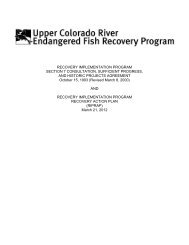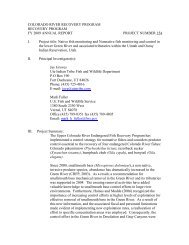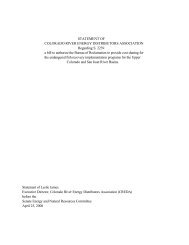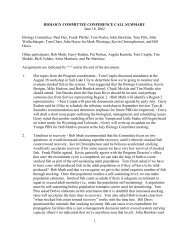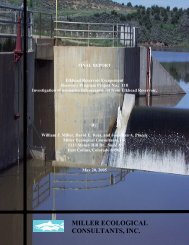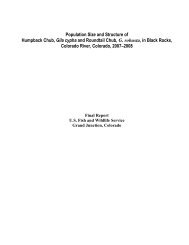K. R. Bestgen, K. A. Zelasko, and G. C. White. Monitoring ...
K. R. Bestgen, K. A. Zelasko, and G. C. White. Monitoring ...
K. R. Bestgen, K. A. Zelasko, and G. C. White. Monitoring ...
Create successful ePaper yourself
Turn your PDF publications into a flip-book with our unique Google optimized e-Paper software.
• Sampling for larvae in the lower <strong>White</strong> River where reproduction was documented for<br />
the first time in 2011 should continue at levels outlined in Project 22f.<br />
• Sampling in the lower Yampa River for razorback sucker larvae may be warranted but at<br />
a low level that may include near shore seine sampling conducted within 1–2 weeks after<br />
first appearance of middle Green River larvae.<br />
• Sampling for razorback sucker larvae in the Colorado River should proceed in<br />
accordance with plans to evaluate razorback sucker reproduction in the lower Gunnison<br />
<strong>and</strong> Colorado rivers per Project 163. When higher levels of reproduction there are noted,<br />
the monitoring program should be revised to incorporate new information on distribution<br />
of larvae relative to spawning areas <strong>and</strong> establishment of sentinel locations that can be<br />
used to monitor timing of reproduction <strong>and</strong> population abundance over time.<br />
• Although early life stage sampling programs are efficient, additional experimental<br />
sampling program evaluations are needed to verify what we think sampling data suggests.<br />
Those experiments include but are not limited to light trap attraction distances <strong>and</strong><br />
sampling efficiency studies in the lab <strong>and</strong> the field, <strong>and</strong> field releases of marked larvae<br />
near spawning areas <strong>and</strong> wetl<strong>and</strong> breaches to assess dispersal <strong>and</strong> wetl<strong>and</strong> colonization.<br />
Occupancy analyses may also aid in determining colonization probabilities of larvae in<br />
wetl<strong>and</strong>s, given that detection probabilities of larvae in wetl<strong>and</strong>s may be less than one.<br />
• Morphological techniques are the benchmark for identification of larvae <strong>and</strong> are reliable.<br />
Verification of identity of larvae via appropriate genetic techniques, especially identities<br />
that are questionable, would be useful. Minimally, such a study needs to be conducted<br />
with an appropriate design, including development of sufficient taxonomic markers, <strong>and</strong><br />
reliably identified reference populations from across the ranges of c<strong>and</strong>idate taxa.<br />
• Real-time monitoring requires continued real-time identification of razorback sucker<br />
larvae in samples collected in the middle Green River. Annual updates of early life<br />
history sampling <strong>and</strong> data collection is needed to inform management.<br />
• Existing sampling programs, especially Colorado pikeminnow abundance estimation<br />
sampling, provides useful data with which to monitor razorback sucker populations in the<br />
Green <strong>and</strong> Colorado rivers.<br />
• Although estimates generated from analyses of razorback sucker recapture data were<br />
mostly unreliable, some were noteworthy. Relatively low population sizes were apparent<br />
in spite of large numbers of stocked fish in the system, supporting previous analyses that<br />
48




